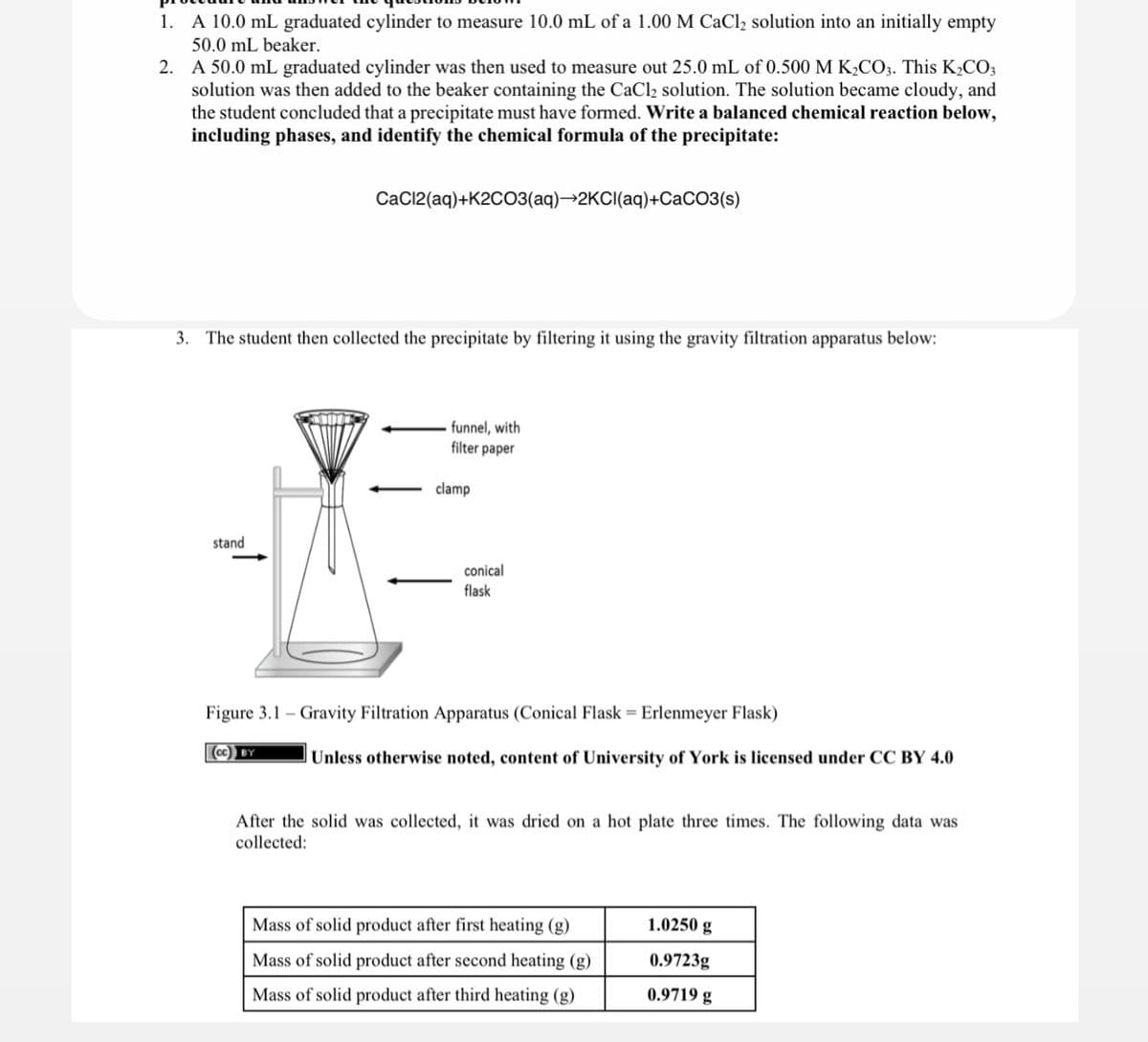Chemistry & Chemical Reactivity
10th Edition
ISBN:9781337399074
Author:John C. Kotz, Paul M. Treichel, John Townsend, David Treichel
Publisher:John C. Kotz, Paul M. Treichel, John Townsend, David Treichel
Chapter1: Basic Concepts Of Chemistry
Section: Chapter Questions
Problem 49RGQ: Fluoridation of city water supplies has been practiced in the United States for several decades. It...
Related questions
Question
Question 3

Transcribed Image Text:1. A 10.0 mL graduated cylinder to measure 10.0 mL of a 1.00 M CaCl2 solution into an initially empty
50.0 mL beaker.
2. A 50.0 mL graduated cylinder was then used to measure out 25.0 mL of 0.500 M K,CO3. This K2CO3
solution was then added to the beaker containing the CaCl2 solution. The solution became cloudy, and
the student concluded that a precipitate must have formed. Write a balanced chemical reaction below,
including phases, and identify the chemical formula of the precipitate:
CaCl2(aq)+K2CO3(aq)→2KCI(aq)+CaCO3(s)
3. The student then collected the precipitate by filtering it using the gravity filtration apparatus below:
funnel, with
filter paper
clamp
stand
conical
flask
Figure 3.1 - Gravity Filtration Apparatus (Conical Flask = Erlenmeyer Flask)
c BY
Unless otherwise noted, content of University of York is licensed under CC BY 4.0
After the solid was collected, it was dried on a hot plate three times. The following data was
collected:
Mass of solid product after first heating (g)
1.0250 g
Mass of solid product after second heating (g)
0.9723g
Mass of solid product after third heating (g)
0.9719 g

Transcribed Image Text:3. Using stoichiometry, calculate the limiting reactant, and the theoretical yield (the mass of CaCO3
product) for the reaction.
Expert Solution
This question has been solved!
Explore an expertly crafted, step-by-step solution for a thorough understanding of key concepts.
This is a popular solution!
Trending now
This is a popular solution!
Step by step
Solved in 2 steps

Knowledge Booster
Learn more about
Need a deep-dive on the concept behind this application? Look no further. Learn more about this topic, chemistry and related others by exploring similar questions and additional content below.Recommended textbooks for you

Chemistry & Chemical Reactivity
Chemistry
ISBN:
9781337399074
Author:
John C. Kotz, Paul M. Treichel, John Townsend, David Treichel
Publisher:
Cengage Learning

Chemistry for Engineering Students
Chemistry
ISBN:
9781337398909
Author:
Lawrence S. Brown, Tom Holme
Publisher:
Cengage Learning

Introductory Chemistry: A Foundation
Chemistry
ISBN:
9781337399425
Author:
Steven S. Zumdahl, Donald J. DeCoste
Publisher:
Cengage Learning

Chemistry & Chemical Reactivity
Chemistry
ISBN:
9781337399074
Author:
John C. Kotz, Paul M. Treichel, John Townsend, David Treichel
Publisher:
Cengage Learning

Chemistry for Engineering Students
Chemistry
ISBN:
9781337398909
Author:
Lawrence S. Brown, Tom Holme
Publisher:
Cengage Learning

Introductory Chemistry: A Foundation
Chemistry
ISBN:
9781337399425
Author:
Steven S. Zumdahl, Donald J. DeCoste
Publisher:
Cengage Learning

Chemistry & Chemical Reactivity
Chemistry
ISBN:
9781133949640
Author:
John C. Kotz, Paul M. Treichel, John Townsend, David Treichel
Publisher:
Cengage Learning

Chemistry: Principles and Reactions
Chemistry
ISBN:
9781305079373
Author:
William L. Masterton, Cecile N. Hurley
Publisher:
Cengage Learning

Chemistry: The Molecular Science
Chemistry
ISBN:
9781285199047
Author:
John W. Moore, Conrad L. Stanitski
Publisher:
Cengage Learning